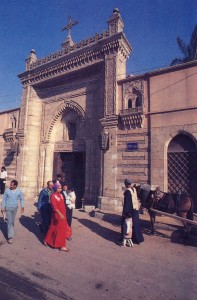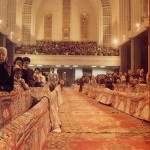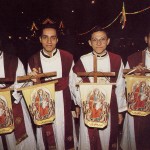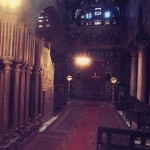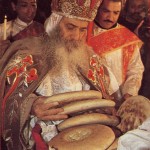Photography and text by Dave Bartruff
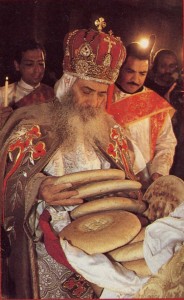
Pope Shenouda in, head of the Coptic Orthodox Church, conducting the Christmas Communion at St. Mark's.
Egypt’s Christian roots reach back through the ages to the infancy of Jesus Christ. As a baby, with Mary and Joseph, he fled Palestine and the wrath of King Herod to the land of the Nile. Here the Holy Family stayed until Herod died, fulfilling Old Testament prophecy of God’s son being called out of Egypt.
Many places in Cairo and its environs are venerated as sites Jesus and his parents visited during their sojourn. The Coptic Orthodox Church traces its origins to Mark the Apostle, who is said to have arrived in Egypt in A.D. 42. Thus, Egypt’s church might well be the oldest in Christendom. The English word Coptic, meaning “Egyptian Christian,” derives from the Arabic qubt and Greek aigyptios, both meaning “Egyptian.” Coptic also refers to the Egyptian alphabet. Developed from the Greek letters, it replaced hieroglyphics in the fifth century.
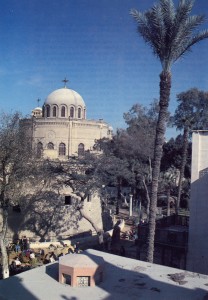
Most of the ancient Coptic land marks are found in Old Cairo. Here is the old Roman fortress called Babylon, which houses the church and monastery of St. George.
Through Saint Mark’s works, vast numbers of Egyptians embraced Christianity, but Roman persecution thinned their ranks. The Arab invasion of A.D. 639 further diminished the Christian community. Yet today, one of every ten Egyptians is Christian.
Most Coptic landmarks are found surrounding the first-century Roman fortress called Babylon. The Coptic Museum is here. Its prized possession is the Nag Hammadi Codices, a collection of more than one thousand papyri bound in leather.
Next door is the Church of the Holy Virgin, known as El Moalaqa, or the “Hanging Church,” since it was built into the Roman fortress wall between two bastion towers. Dating from the late fourth century, it is the largest and most elaborate Coptic church in Old Cairo. Its alabaster pulpit rests on thirteen pillars. One is black, symbolizing Jesus’ betrayer, Judas.
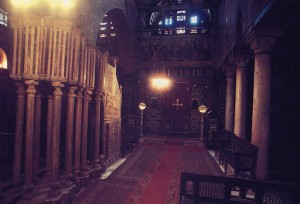
The sanctuary of the Church of the Holy Virgin, known as El Moalaqa. The alabaster pulpit is suppored by thirteen pillars, once of which is black to symbolize Jesus' betrayer, Judas
Close by, but reachable only through a twisting maze of narrow lanes, is the Church of St. Sergius. A sign indicates that it is the oldest church in Egypt. According to tradition, the Holy Family found shelter in a cave beneath the site.
St. Barbara’s, a third Coptic church in the vicinity, also dates from the fourth century. Its portal is a masterpiece of wood carving.
Across the city in Heliopolis is the site of the Virgin’s Tree. Here water sprang from the ground at Jesus’ command, according to tradition. Pilgrims still enjoy refreshment from the well.
The Coptic Church has its own calendar, conceived in A.D. 284 and followed to this day.
It is believed to be a continuation of the ancient pharaonic solar calendar. According to the Coptic calendar, Christmas falls on January 7. The focal point of the Egyptian celebration is the service held Christmas Eve in St. Mark’s Cathedral, and conducted by the Coptic pope himself.
The ceremony begins several hours before midnight and lasts into the early hours of Christmas Day. Outside the cathedral, a myriad of colored lights illuminates a bazaar of booths selling festive foods and Coptic icons. Inside the huge sanctuary, hundreds of Oriental carpets decorate the aisles and walls as more than five thousand Coptic Christians gather to honor their Savior, who long ago found refuge in their country.
- Brother Zechariah, the caretaker of St. Sergius’ Coptic Church.
- A resident of Cairo displays a tattoo typical of Coptic Christians.
- An incense bearer walking down the aisles of St. Mark’s during the Christmas ceremony
- Nearly 5000 worshipers fill St. Mark’s Cathedral to take part in the Christmas celebration
- The exterior of St. Mark’s Cathedral, once the largest church in North Africa.
- A Coptic father talks with a young parishioner outside St. Peter’s Coptic Church.
- Brightly colored lights illuminate booths in front of St. Mark’s Cathedral on Christmas Eve.
- Members of the choir prepare to sing for the Christmas service in St. Mark’s.
- The exterior of El Moalaqa
- The sanctuary of the Church of the Holy Virgin, known as El Moalaqa. The alabaster pulpit is suppored by thirteen pillars, once of which is black to symbolize Jesus’ betrayer, Judas
- Most of the ancient Coptic land marks are found in Old Cairo. Here is the old Roman fortress called Babylon, which houses the church and monastery of St. George.
- Pope Shenouda in, head of the Coptic Orthodox Church, conducting the Christmas Communion at St. Mark’s.

